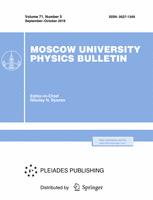The influence of heating after sharp cooling to −60°C on the low-frequency dielectric response of erbium formate crystallohydrate is investigated. Such research has been performed previously for objects of different chemical natures and structural organizations (in colemanite, diglycinenitrate, triglycinetellurate crystals, and several polymers with water). There is one structural fragment in these substances, viz., a weak hydrogen bond O...H-O that is 0.26–0.29 nm in length. A common feature of these measurements is a sharp increase of dielectric permittivity of the orders at frequencies of 0.1–4 Hz close to 0°C, upon heating after sharp cooling, and decay in the region of 40°C. To explain similar phenomena one can use the deformation model of the double minimum potential in the field of the thermoelastic stresses and other molecular fields.
77.84.Jd Polymers; organic compounds
77.80.Bh Phase transitions and Curie point
Faculty of Physics, Moscow State University, Moscow, 119991, Russia



